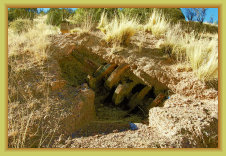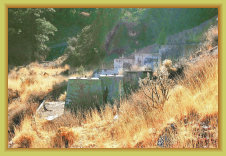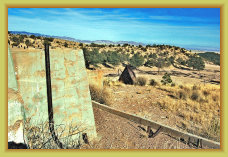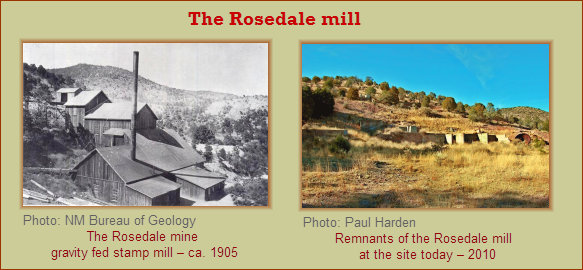On this page:
The new Rosedale mine and mill began operations in 1913, rebuilt following the 1910 fire. With a new 20-stamp mill now
in operation, production was soon allowed to increase back to revenue levels from before the mill fire. This persisted over
the next three years until . . .
1916 DISASTER
The mill was processing about 450 tons of high grade ore per month when another
fire struck in 1916. The fire destroyed the mill, cyanide plant, and spread into the mine to burn some of the
wood shoring and the main shaft timbers down into the mine. This 3rd fire, with another period of mine inactivity,
marked the decline of the Rosedale mine.
According to the oral history of
Edwin Burris, recorded by the Socorro County Historical
Society in 1973,
"the mine is about 735 feet deep and there's lots of drifts and things down there. My father used to work in them
mines ... and I guess them mines has just petered out, I don't know. "
The Rosedale mine did not
just "peter out." It was irreparably damaged by both water and fire. The main shaft of the Rosedale mine was indeed 735
feet deep where they hit water and could work the vein no deeper. After the 1916 fire, much of the mine was filled with
carbon dioxide and other deadly gasses making the air unbreathable. Since CO2 is heavier than air, it settled to the lower
reaches of the mine, where the deadly gasses remain suspended in the mine to this day. The fire in the shaft and drifts also
compromised the structural integrity of the mine, causing unstable collapses in several areas.
After the fire, the owners appealed
to mining and engineering companies to propose plans to return the mine to operation. Several concerns inspected the
damaged mine and all agreed the mine, flooded near the unworked vein, collapsed portions of the shaft, and filled with deadly
gasses, left the Rosedale mine mortally wounded. The only option was to build a new 700-foot deep shaft to access the vein
and a new mill to process the ore a financially prohibitive option.
1930s Great Depression. There was a slight surge in mining activity in the west and southwest during the Great Depression
as men were willing to work for lower wages and the cheap (sometimes free) availability of housing in the mining camps in which to
live. Rosedale was no different. On April 19, 1933, President Franklin D. Roosevelt suspended the Gold Standards
Act which raised the government-set price of gold from $20.67 per ounce to $35.00 per ounce. This bolstered mining a bit and
allowed the Rosedale mine to continue operations on a limited basis.
1934 New Owners. After the Rosedale mine sat dormant
for nearly ten years, it was purchased by the Black Bear Mining Co. and operated under the name Rosedale Mining & Milling
Co. The new owners soon faced the problems of the previous operators a collapse in the main shaft prevented access to
the vein, still flooded at 735 feet, and the dangerous gasses from the 1916 fire had not dissipated to safe levels, all preventing
underground work. They built a small mill with a rock crusher and 65-ton per day cyanide plant to
process what was left of the
reserve ores from
previous mining operations, and to reprocess
some of the tailings with some success.
In 1935, the operation
was again reorganized
under the name Rosedale Gold Mines Inc.,
Ltd. 58 tons of concentrate was shipped that
year to the
ASARCO smelter in El Paso which
returned 158 ounces of gold and 147 ounces
of silver for a value of $5,641. The following
year,
they expanded the cyanide plant to
process 135 tons per day which yielded 1,631
ounces of gold and 2,682 ounces of silver for a
value
of $59,174.
1937 Closure. The Rosedale mine operated for 233 days in 1937
averaging about 116 tons of ore concentrate
per month shipped to the smelter. This produced 1,665 ounces of gold and 2,291 ounces of silver for a value of $60,062 (about
$1 million today) by the end of the year. It is not known what the profit on operations were. On December 2, with virtually
all the available ore and cyanide slurry exhausted, the company closed its doors. The last of the miners and their families
left, leaving the mine and the town totally abandoned, but the cyanide mill still in place. Ownership reverted to the Premier
Trust Co., likely through default or forfeiture.
The Rosedale Mine and Mill
(Part 2: 1913Present Day)
19131927
Rosedale Mine
33.8089°N 107.4061°W Elev. 7250 ft. ASL
Links:
Socorro County Historical Society
Socorro, New Mexico, USA
History
Articles
Rosedale and the Rosedale Mines
Mines3
3




Photo: NM Bureau of Geology
The Rosedale
mine
gravity fed stamp mill ca. 1905
Operation of the Rosedale Stamp Mill
Photo: Western Mining History
A 10-stamp mill (two 5-section units) similar to the Rosedale mill.
Note cam shaft driving the
stamps on bottom.
One of the Rosedale stamp mill
cam shafts still at the mill site
today 2010
Concrete foundations and pedestals at the mill site today that once supported the ore shoots and stamp mill machinery and the cyanide plant. These ruins are the mill that burned in 1916 and totally destroyed.


The Rosedale mine workings
From: "The Ore Deposits of Socorro County, New Mexico," NM Bureau of Mines, 1932
Vertical profile of the Rosedale mine
Ore from the mine is delivered to the mill in ore cars and emptied into the ore shoot at the head of the mill. This raw ore is
the size of bricks to basketballs, or larger. The ore in the inclined ore shoot moves by gravity, and assisted by workers, into
the rock crushers, which reduces the gold laden ore to gravel sized pieces. This smaller ore is next fed to the stamp mills which
crushes the gravel sized ore to about the size of sand, and mixed with water to form a slurry. This is sent to shaker and
flotation tables that allows the heavier gold to sink to the bottom for collection and all other materials and the water mix to be discarded.
In later years of the mine, a cyanide plant was added to the mill. The cyanide solution was used for separating the gold
from the slurry by placing the slurry into tanks, with agitation, to allow the heavier gold to settle to the bottom for collection.
This increased recovery of the gold metal for higher profits. Allowed to dry in the settling ponds, this gold rich slurry is
the concentrate sent to the smelters in El Paso to be melted down for forming the gold bullion, which was then purchased
by the U.S. Treasury or other commercial enterprise (jewelry, industrial uses, etc.).
See this video for the operation of a 10-stamp mill (external website) from the State Mountain mine in California.
or,
this video (jump
to 7:00 min.) for another working 10-stamp mill at the Mojave Desert Heritage and Cultural Center (external website).
Imagine
listening to that sound in the video 24 hours a day. No wonder the town of Rosedale was located about a mile away from
the mill!
1940's WWII Era saw another surge in mining, mostly to support the war effort. This included some of the mines
in Kelly and around Socorro supplying lead and manganese, but not Rosedale. During the war, the demand was for war metals, not
precious metals, which kept the price of gold around $36-37 per ounce throughout the war.
In 1941, Nora Carrara of Magdalena,
NM bought the deed to the Rosedale mine from the Premier Trust Co. for just $500. Using the abandoned cyanide plant, the brief operation
only yielded 35 ounces of gold and 128 ounces of silver for a $1,316 return. This is the last known attempt to extract
gold from the Rosedale mine. In 1942, an auction was held which sold the remaining machinery and items of value, leaving
the mine and cyanide mill building vacant. A few houses in Rosedale were moved to Magdalena for housing; the majority of structures
were simply dismantled for the wood and furnishings. By the 1950s, virtually nothing of the town of Rosedale or the mine remained.
Today, only the concrete ruins of the stamp mill and boiler pedestals remain along with a few pieces of rusted machinery.
In 1917, Jonathan Worrell purchased the remaining interest in the operation from the W.H. Martin Co. for $42,664, operating under
the name Rosedale Mines Corp. Worrell's plan was to use the reserve ore ore removed from the mine before the fire. Additionally,
mining continued in the stopes on the upper levels with a reduced work force where small pockets of gold ore, some
missed previously, were worked. A few men operated the cyanide plant recovering traces of gold from the tailings. Without the
mill machinery, crushing the ore and attempting to recover the gold was all accomplished with manual labor. Production
continued, though limited compared to the glory days. It was a slow, tedious process, but profitable gold was being returned
from the smelter. The mine operated in the manner, though often sporadically, for the next several years.
By the 1920s,
only a skeleton crew remained working the Rosedale mine. Production was also declining from the New Golden Bell mine south of
Rosedale. The other area mines and prospects, such as the Whitecap and Baking Powder claims, had long been abandoned. This was typical
throughout the west as dropping demands and prices for mined metals following WWI left few mines in operation by the 1920s. Many
of the mines in the Kelly Mining District had also closed.
Many of the furloughed miners and town's people began to leave Rosedale,
looking for employment elsewhere. With the majority of local mines now closed, including at Kelly, many were forced to find non-mining
jobs; others became area ranchers.
In 1921, 35,000 tons of ore were reported as mined by the struggling Rosedale mine and declined
after that. The mine operated only sporadically until . . .

Death of the owners. Rosedale owner Dr. Jonathan P. Worrell died at his home in Terre Haute, Indiana in 1924 at 80 years of age. He
left a substantial estate and his mining and business ventures to his wife, Mary, now 77 years of age. There was an attempt to sell
Dr. Worrell's various holdings when Mary Worrell died in 1927. The executors of the estate continued their efforts to liquidate
the Worrell family holdings.
After the death of Dr. Jonathan Worrell in 1924, and his wife Mary in 1927, the estate attempted to sell the Rosedale mine with no results. The mine sat dormant with no real owner or operator until 1934.
PRESENT DAY: RECENT ACTIVITY
The Rosedale Mining District has received some recent attention since the 1941 closure taking
advantage of new technologies and processes to assess the potential for future mining activities. In short, "there's still gold in
them there hills," possibly rich gold and silver ore, but the veins are deep, 300500 feet deep or more, and perhaps near the water
table. With no assurance of recovering profitable gold without an extensive mining operation, working the vein is considered prohibitive
at this time.
1975-1976 The
Perry, Knox, and Kaufman, Inc. (PKK) performed prospecting and mapping surveys of the Rosedale
and Golden Bell mining areas. While results were inconclusive, surface samples and drill holes did find traces of gold and silver
and identified a vein. However, future mining development was not warranted.
1990 Charles Ferguson of the
Sunshine Mining
Co. conducted geochemical analysis of the mining district with the same conclusion as PKK that gold likely exists at depth requiring
extensive workings to access.
2007 The
Cibola National Forest, Magdalena Ranger District, began the
Rosedale Mine and Mill Cleanup
Project to reclaim the heavy metal contamination from the cyanide settling ponds and tailings as part of the
Abandoned Mine Lands program.
This included an archaeological
inventory of the Rosedale mine of all historic and cultural remains as part of the cleanup conducted
by Burney & Associates, Taos, NM.
2016 State of NM awards a 1-year permit for the Holley-Rosedale Exploration Project,
awarded to Mr. and Mrs. Fred Holley of Dove Creek, CO. Permit to drill six exploration drill holes 500 ft. deep. What exploration
was performed and the results is not known.
New Mexico Tech University New Mexico Bureau of Geology and Mineral Resources (formerly
New Mexico Bureau of Mines) also conducts periodic surveys and assessments of the Rosedale district for mining research, geologic
studies, academic knowledge, and other reasons, and in conjunction with the Abandoned Mine Lands program.

Photo: NM Bureau of Geology
The small mill built by the Black Bear Mining Co. that processed the Rosedale ores from 1934 to 1937.
Mines3
0920/19







